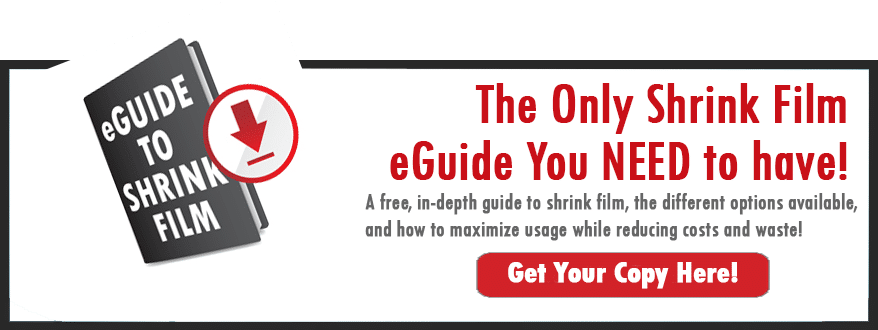How to Choose the Right Shrink Film & Shrink Film Machine
Equipment | Packaging Materials | The Business of Packaging | Packaging Design | Food Packaging
If you’ve heard about the benefits of shrink film for product packaging and you’re interested in applying this option at your business, you’re making a smart move. Shrink film is an excellent packaging solution for many types of products, offering valuable advantages like flexibility, durability, printability, shelf appeal and environmental friendliness. Even so, implementing a shrink film packaging design and process can be confusing if you don’t have sufficient information.
When it comes to choosing the right shrink film and machinery, there’s quite a bit to consider to ensure that your end product meets a high standard of quality. From understanding the proper gauge, size and clarity for your shrink film to evaluating shrink tunnel length, packaging purpose, storage and environment, it’s important to consider all of these details. Use the following expert tips to select the right shrink film and machine for your needs.
Learn all about the different types of shrink film and their ideal uses with this handy eGuide!
Determine the Proper Gauge
The size and specifications of the shrink film you use have an impact on the overall cost of packaging your product. Shrink film is priced by gauge and width, so a thicker gauge film has a higher cost than a lower gauge film. Most companies use shrink film that is too thick for their application, usually because it allows them to get away with employing less efficient machines, less experienced or competent operators or even a sub-par setup.
However, reducing your gauge to precisely what you need can drastically cut costs on the price of shrink film and maintenance. Instead of determining gauge haphazardly, it’s better to assess your exact requirements. For reference, the following chart details thickness conversions for your film measurements:
| Gauge | Mils | Inches | Microns |
| 1 | 1/100 | 1/100,000 | .254 |
| 100 | 1 | 1/1000 | 25.4 |
*Note that the smaller the gauge, the thinner the film as opposed to different materials like jewelry, where a 14 gauge would be smaller than a 0 gauge. A 45 gauge film is thinner than a 100 gauge film.
The heavier the gauge, the longer it will take to make a proper seal, which wears your machinery down faster and necessitates more frequent maintenance. Today, there are options for thinner, stronger shrink films that minimize the need to overcompensate with gauge thickness. It's worth running some film tests on your products to figure out what gauge you need to properly protect your product without wasting money on thicker film.
Identify the Best Packing Method for Your Product
When packing rigid or heavy materials, many companies rely on the strength and durability of corrugated boxes. If you are using this packaging method, consider that there may be a better alternative for your products. Given the durability of polyethylene shrink films, they can often handle the load of heavy and/or rigid products without the need for a corrugated option. If you intend to use shrink film as a primary packaging solution and you need the product to have visual appeal, you’ll want to take the following factors into consideration:
- High-quality films are a must. For example, cross-linked polyolefin (POF) film provides high-tensile strength and incredible clarity for a glossy shelf appearance. It’s optimal for consumer products when presentation is critical or when bundling multiple items together. It’s less affected by temperature changes than other films and has the ability to shrink quickly and completely, resulting in a finished good as soon as it comes out of the shrink tunnel. Some films have excellent printability for high-quality graphics that can eliminate the need for additional labeling, creating a more efficient packing process.
- Use appropriate shrink tunnel settings. Assess the heat of your shrink tunnel to ensure it is putting out enough heat to properly wrap the package without damaging your product. Choose your conveyor speed carefully to minimize defects in the final packaging appearance.
- Give extra attention to perforated shrink film. Perforated film has very small holes throughout, which allow air to escape as the film is shrunk around the product, creating a better looking finished good. If a non-perforated film is exposed to hot air after sealing, the air inside of the plastic expands and can cause the shrink film to balloon. The tiny vent-holes are practically invisible to the naked eye when a product is completed, so if your product is not perishable, this type of film may be an ideal option.
Focus on the Speed and Size of the Machine’s Shrink Tunnel
The shrink tunnel is one of the most important elements to consider in the shrink film packaging process, and it’s paramount to ensure that you’re running it at the optimal speed and using the right size machine for your products.
If the speed of the shrink tunnel is too fast, the film won’t heat up properly and you risk developing round or oval patterns in the plastic (often referred to as “fish eyes”), which look unprofessional and sloppy. High speeds can also lead to an incomplete sealing cycle, resulting in thin strands of melted plastic, or “angel hairs” that stretch from the product and the sealed part of the film. Make sure you’re choosing a speed that enables adequate heating and sealing while rendering profitable production. There are tunnels available to meet practically any need for throughput, so discuss your needs with your supplier to find the right match for your business.
As far as the length of the shrink tunnel, be sure it’s not too short. It should be long enough so that the shrink film has enough time to heat up properly and evenly. Even if you apply higher heat to a shorter tunnel, you can end up with hot spots that diminish quality in the final packaging output.
Review Your Unique Storage and Handling Needs
Not every shrink film is appropriate for every environment, so make sure you choose the one that matches your company’s specific storage and handling needs. Because certain options are sensitive to climate, be aware of the storage requirements for various film types so you are not working with climate-compromised packaging.
In general, shrink packaging is best stored in temperatures between 30 and 77 degrees Fahrenheit. If your facility has areas of high heat, it’s important to keep your shrink materials stored in the coolest areas without subjecting them to refrigeration. If shrink sleeves are kept in temperatures exceeding 100 degrees, they may prematurely shrink and compromise their ability to protect your goods. Conversely, if a PVC material becomes too cold from refrigeration, it can become brittle and useless. If you’re packaging frozen foods and other items that must be cooled in a refrigerator, it may be a good idea to use a quality polyolefin film instead.
Finally, think about your shipping process. If you do not have a freight carrier that offers temperature-controlled shipping options, this will affect what type of shrink film you need for continuous protection and packaging quality.
At the end of the day, choosing the right shrink film and machinery for your products requires a multi-faceted approach that considers everything from environmental factors and packaging purpose to shrink tunnel specifications and more. It’s best to discuss your product and your facility with your packaging supplier to determine the most suitable options available to you.
Looking for more information about shrink? Download your free eGuide to Shrink Film to access a more in-depth rundown of the different options available to you.
About David Roberge
I am grateful for my 9 years as part of the outstanding Industrial Packaging team. I was able to hang out with some of the most knowledgeable folks in the packaging industry. I feel even luckier that I was able to share that knowledge with you. I love learning, hiking, and growing people and teams both personally and professionally, and helping companies grow better.




